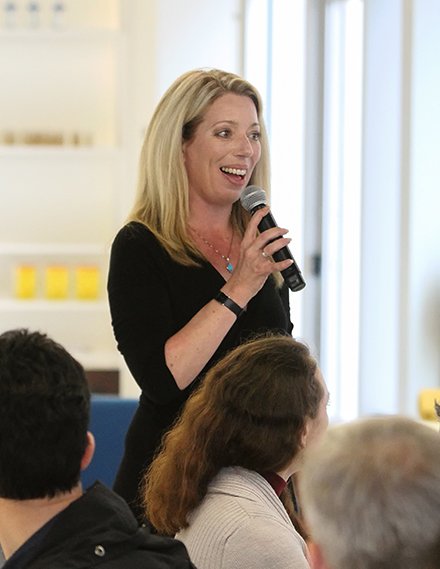Getting Things Done In A World Full Of Distractions

During the workday, most of us are bombarded with notifications that divert our attention, distract our focus, and demand immediate action. So how do you get work done when you have to switch tasks and refocus all the time, only to be interrupted moments later? This is a critical question in today’s workplace, and World Productivity Day is the ideal time to address it. So, celebrating the importance of productivity, let’s look at what it means and how it should power today’s (and tomorrow’s) hybrid workplace.
Also Read: Why Discussing Your Problems With Coworkers Can Boost Your Productivity

DISTRACTION DRIVEN
Productivity does not imply more work. Instead, it is “the ability to complete a specified amount of work in less time.” What’s missing from this definition are the constant distractions that today’s workers face—and how these distractions affect productivity. According to research, it takes a person 23 minutes to regain their previous level of thought after being distracted. This is because when we switch to a new task, our brain must stop processing what we’re doing.
We must then return to the original work and refocus. As a result, pivoting to a quick task (such as responding to a Slack message) typically takes longer than the task itself. The bottom line is that we waste 23 minutes for every ding, ping, or ring that disrupts our concentration.
The constant “focus-shift-refocus” we experienced at work has followed us home. We had chatty coworkers and an open-plan office in the office. We have children, pets, and a mountain of laundry at home. Furthermore, the new technology we implemented to support remote work has introduced a new set of distractions.
Also Read: Plans To Obtain A Balance Between Passion And Personal Growth
Consider “@ mention” alerts in your documents (doc, Figma file, or pull request) and real-time collaborative messaging in tools such as Slack and Teams. They are intended to cause us to stop our actions and check the most recent alert or notification. Unfortunately, this has led to a culture where people expect a quick response and have FOMO if they miss an important update or don’t join a conversation in real-time.
The issue is that if I receive five notifications in five minutes, there is no differentiation in terms of urgency. One alarm could alert me that our entire system is down. Another person may notify me that my sandwich has arrived. I have no idea which tasks can be completed quickly without delving into each notification to assess and analyse it. Even if you give yourself five minutes to accomplish what you think will be a quick task, it quickly becomes a 15-minute scavenger hunt.
Some of the information you require may be buried in a document, while the context may be concealed within a Slack message. We often have to sort through a maze of information because different departments rely on various tools, documents, and spreadsheets. After all, we all work cross-functionally today.
LEVEL BY LEVEL, GETTING TO “PRODUCTIVE”
Productive employees are happy employees (who doesn’t like the feeling of accomplishment? ), and an effective business will reach critical growth and profitability milestones more quickly. In essence, significant work is being completed with fewer resources in less time, and this productivity is reflected in operational and business metrics. So, how do you start and run a profitable business?
The most important thing you can do as a leader is to clarify all employees’ goals and priorities. You can make company, department, and team-level goals available for all to access, read, and reference. This ensures that the appropriate people are working on the relevant tasks correctly and that they are not wasting time on less critical tasks. So how do you motivate people to do the right thing?
First, ascertain that they have the necessary tools (and time) for the job. Then, because the most valuable work necessitates (human) thought, creativity, and analysis, let automation, AI, and ML handle the stare-and-compare tasks. This frees up your employees’ time to focus on strategic, high-value work that provides world-class experiences for your customers.
Companies in the product realm must prioritise action over perfection. If you overanalyze, you will become paralysed by analysis paralysis. There are two types of doors: one-way doors and two-way doors. Reversing a one-way door decision can be difficult without a lot of technical time and employee hours. On the other hand, a two-way door decision could mean putting out a small product feature and then going back through the other door to fix, repair, and iterate.
One important product-related lesson I’ve learned about one-way and two-way door decisions is that product teams must differentiate between the two from the start. Only devote significant time to researching, debating, and discussing one-way door decisions. Form your hypothesis with the least amount of information possible for a two-way door and act quickly.
Also Read: JOURNEY OF AN ENTREPRENEUR

Many businesses waste time researching, debating, and discussing two-way doors when they should be researching, debating, and discussing one-way doors. The more two-way door features a company develops, the better—innovative, small two-way door features can generate value and propel a company forward. As you work toward perfection, your customers will notice how these “value-add” pieces make a difference.
At the employee level, I encourage people to prioritise their work using an “urgent by important matrix.” It is not necessary to use a spreadsheet for this; it can be done mentally. Is it “urgent and critical”? If so, you should prioritise that project. Is it “critical but not urgent”? Make time to concentrate on your work. Is it neither critical nor urgent? It might be worth delegating or looking into another workaround. You can turn projects in this matrix into a master checklist that you use to begin and end each day. Check off the items you finished during the day, highlight what you will work on tomorrow, and end the day with a clean slate and a sense of accomplishment.
Employees should feel at ease blocking time on their calendar for focused work and thought. It is acceptable to say “no” or “not now”; not everything must be completed immediately. Consider when and where you are most productive. Can you concentrate for six hours, or do you work best in shorter bursts? Are you more effective in the morning or a night owl who works best after the day’s craziness has passed? Employers can give workers the tools they need to do their best work by supporting and valuing their different work styles.
Despite the modern workplace’s flexibility and advancements, it often feels like we’re playing “whack-a-mole” when we hear various alerts and notifications. How many pings did you receive on your device while reading this article? Workers must contend with alert fatigue, information overload, and constant distractions. Commit today to double down on productivity by considering how you and your team can get into — and stay in — the productivity zone to do the best work to move the needle for your company.
connect with us on social media [ Facebook | Instagram | Twitter | LinkedIn ] to get real-time updates on the market. Entrepreneurs Diaries is now available on Telegram. Join our telegram channel to get instant up






